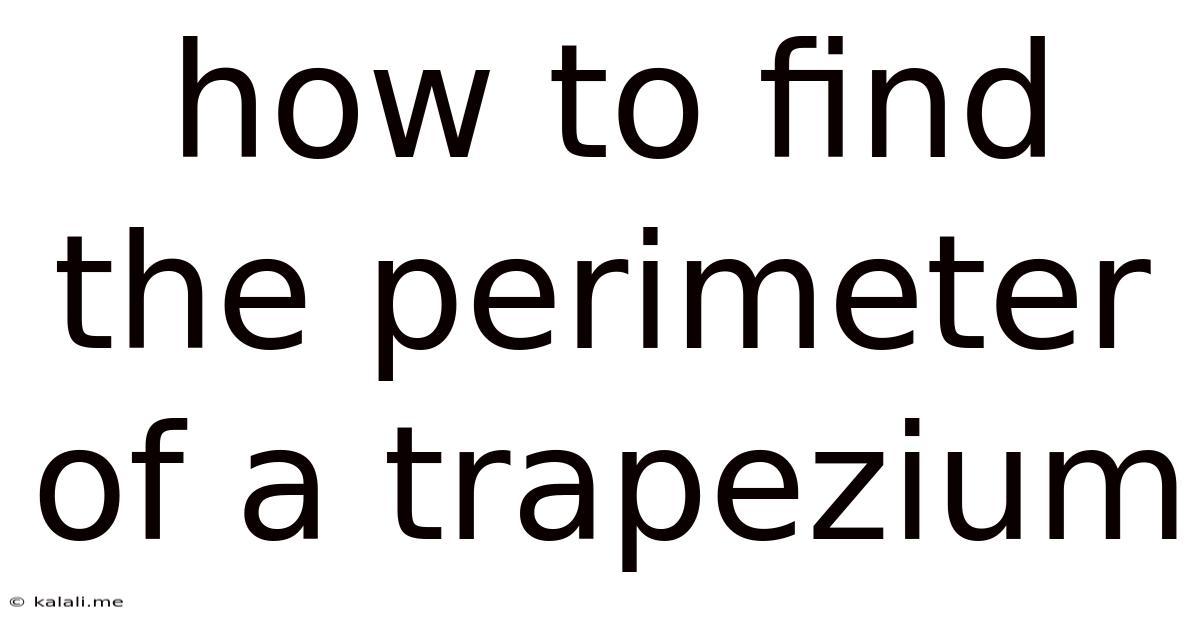How To Find The Perimeter Of A Trapezium
Kalali
Jun 11, 2025 · 3 min read

Table of Contents
How to Find the Perimeter of a Trapezium: A Step-by-Step Guide
Finding the perimeter of any shape is straightforward: simply add up the lengths of all its sides. This article will guide you through calculating the perimeter of a trapezium, a quadrilateral with at least one pair of parallel sides. Understanding this simple geometric concept is crucial for various applications, from basic geometry problems to more advanced architectural and engineering calculations. This guide will break down the process, offering clear explanations and examples.
What is a Trapezium?
A trapezium (also known as a trapezoid in some regions) is a four-sided polygon with one pair of parallel sides. These parallel sides are called bases, and the other two sides are called legs. The lengths of these sides are crucial in calculating the perimeter. Unlike other quadrilaterals like rectangles or squares, a trapezium doesn't have any specific relationship between its angles or side lengths beyond the parallel bases.
Calculating the Perimeter: A Simple Formula
The perimeter (P) of a trapezium is simply the sum of the lengths of its four sides. Let's represent the lengths of the bases as 'a' and 'b', and the lengths of the legs as 'c' and 'd'. The formula is:
P = a + b + c + d
This means you need to know the lengths of all four sides to determine the perimeter.
Step-by-Step Example
Let's work through an example. Imagine a trapezium with the following side lengths:
- Base a = 5 cm
- Base b = 8 cm
- Leg c = 4 cm
- Leg d = 6 cm
Following the formula:
P = 5 cm + 8 cm + 4 cm + 6 cm = 23 cm
Therefore, the perimeter of this trapezium is 23 cm.
What if I only know some of the side lengths?
Unfortunately, you cannot calculate the perimeter of a trapezium if you only know the lengths of some, but not all, of its sides. You need all four side lengths to apply the formula. Additional information, such as angles or the height of the trapezium, might be helpful in specific cases using trigonometric functions, but it's not sufficient to determine perimeter directly.
Practical Applications
Understanding how to find the perimeter of a trapezium has practical applications in various fields:
- Construction and Engineering: Calculating the amount of fencing needed, determining the length of materials for framing, or estimating the cost of materials based on the perimeter of trapezium-shaped structures.
- Cartography: Estimating distances in maps that involve trapezium-shaped regions.
- Real Estate: Calculating the perimeter of land parcels with trapezium shapes.
- Graphic Design and Art: Determining the dimensions of designs or artwork incorporating trapezium shapes.
Conclusion
Calculating the perimeter of a trapezium is a fundamental concept in geometry. By understanding the simple formula and following the steps outlined above, you can easily determine the perimeter of any trapezium given the lengths of its four sides. Remember, the key is having all four measurements to apply the formula accurately. This skill is valuable in various real-world applications where understanding geometric properties is crucial.
Latest Posts
Latest Posts
-
How Many Calories In A Pound Of Hamburger
Jul 01, 2025
-
How Many Ounces Are In 9 Pounds
Jul 01, 2025
-
What Kind Of Room Has No Doors Or Windows
Jul 01, 2025
-
How Many Cups Of Elbow Macaroni Are In A Pound
Jul 01, 2025
-
How Many Guppies In A 5 Gallon Tank
Jul 01, 2025
Related Post
Thank you for visiting our website which covers about How To Find The Perimeter Of A Trapezium . We hope the information provided has been useful to you. Feel free to contact us if you have any questions or need further assistance. See you next time and don't miss to bookmark.